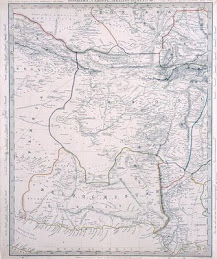
Mir Dost Mohammad Khan Baranzai was the last ruler of Dizak.
DIZAK
An important district on the western frontier of Persian Baluchistan comprising the following sub-district, which go by the general classification of SARAVAN or highland;
A) Dizak and Bampusht
B) Jalk and Kalagan
C) Kuhak
D) Sib-suran and paskuh
E) Irafshan
F) Ashar- arokshan
G) Mages
The rough boundaries therefore on the east and south can be defined as those demarcated by goldsmith in 1871, and Holdich in 1896, between Persian and British territory( Kalat territory); while on the west, the water-shed driving the drainage of the Surha (Sarhad) and Sarbaz rivers marks its western limits. To the north it is open, being bounded by the district of Sarhad, but the division between the two is very ill defined and shadowy.
The sub district mentioned above, though nominally dependent on Dizak, are in reality semi- independent; their Sardar pay little or no attention to orders received, and revenue from them is only collected by armed forces.
The total revenue extorted in 1902 was as follows, but in each year it liable to variation;
Dizak, surjo, shastun and Bampusht, RS. 17500
Jalk and Kalaghan RS 7000
Kuhak 6 camels
Sib-Suran RS 14500
Irafshan, Ashar and Afshan Rs 4500
Magas Rs 3000
46500
Camel 6

Chiefs of Baluchistan",1900
Dizak proper is a valley about 50 miles long by 10 wide, watered by various tributaries of the Mashkid river and is bounded on the west by sunt Kuzak range (rising to an altitude of 6,246 feet) on the east and north by kouh-I-Siahan, and on the south by the valley of the Mashkid. It general elevation is about 4,000 feet.
It contains numerous villages, of which the following may be noted; Hushak, Bukhahan, Shastun, Surjo, Dilavar Khan, Qadir Bakhsh, Muhammadi, Aspich, Zaarat. All of them possess forts, with extensive date groves and cultivation while the village of Dilavar Khan khan is the residence of the Sardar of Dizak.
Traveller wrote;
Supplies in fair quantities are always procurable, while it cotton is famous throughout Baluchistan, being exported as far as Bint. In 1839 there were said to be 1000 weavers settled in the district, but it is not known if this still the case.
The climate is considered good, and it shares with Sib and Magas a reputation for healthiness and fertility unrivalled in Persian Baluchistan.
a) To Sib, via the Sorandar pass;
b) To Vasht, up the Simish valley;
c) To Jalk, via the Brijnan pass;
d) To kuhak, via Isfandak;
The inhabitants of the Dizak villages, as of sib, Jalk, etc, are mostly Arbabis a short, sturdy, but good humored and industrious race, believed by st. john to be akin to the Dehwars of the Brahu highland, and therefore to Tajiks of Afghanistan and starts of central Asia. They are admirable cultivators. Of course the important parts of the population, if not the most numerous, are Baluch of various tribes.
They chiefs family is of Baranzai, they had emigrated from the Helmand valley good many generations ago.
Of the history of Dizak we know little more than other portion of western Baluchistan. It reduced in 1734 by Nadir shah, and with the rest of Baluchistan formed part of the possessions of that conqueror.
When in the zenith of his power, Nader Shah bestowed Dizak on an ancestor of the present chief. On the death of Nadir in1747, Nasir Khan of Kalat became the independent ruler of all Baluchistan. He appears to have confirmed Nader Shah’s grant, bestowing Dizak on Nematullah, whose names seems to be still well known in the country.
Nasir Khan died in 1795, so that the Nematullah, who was chief at the time of Pottinger,s visit in 1810, may have been the same as he who received the Sanad from from Nasir Khan. Hiji Abdul Nabi visited Dizak in 1839, and related that at that time the chief was Mir Gajian, who was very popular in the district. His retainers were Damani Baluch a tribe which appears to be numerous in the whole tract south of Sarhad from Dizak Magas.
In the meantime the Persians had again been asserting a right to Dizak(with the rest of western Baluchistan), and during the reign of Fath Ali shah(1797 to1834), the country was invaded by the Vazir Mirza abdul Qasim, and great part of it was temporarily annexed to the Persian dominations.
The effect on Dizak was the levy of tax of RS.5 on every Hangam, or full water right (a full water right is the owner has the use of the water from the Kariz or channel for one day and night in each 12 or 24 days. A Hangam right is when he has the water for either a day or a night in each round).
Nasir Khan II of Kalat(1841to1857) made vigorous and by no means unsuccessful effort to reassert authority over the territory adjacent to Persia, which had fallen away during the feeble rule of his predecessor. Whether he ever got much hold on Dizak is uncertain; but goldsmith says these petty Baluch states instead of uniting under one recognized head, had no common bond of interest to keep them together, and became the prey of their most powerful neighbours for time being, whether Persia, Afghanistan, or a Baluch Sardar of superior power and ability.
From the history files, M.sarjov,










































No comments:
Post a Comment